
MAY CONTAIN NUTS

Search Shorpy
SHORPY ART

Framed or unframed, desk size to sofa size, printed by us in Arizona and Alabama since 2007. Explore now.
Join and Share
Ad-Free Shorpy
Shorpy is funded by you. Patreon contributors get an ad-free experience.
Learn more.

Recent comments
- Baked goods to go
- Tires
- A Certain Robot
- Still Standing
- All wound up?
- Springy
- This one is inspirational.
- Seasonal Work
- Tomaeto, Tomahto
- Truck ID
- Horton Hears a ...
- From a buggy company came ...
- They call me Mister Horton
- Still Run
- Someone fed Jack some bad info.
- A Beautiful Machine
- It's official.
- Olive Brand Sportswear
- I still have a grudge against Texaco
- No GPS?
- CFG Bank Arena
- Van Lines
- Closed Station?
- John Vachon
- Folding Chairs
- TEXAGO
- Fragi-lay
- Classy
- Passenger seat
- No tipping
Member Photos
The Shorpy
Printporium
Printporium
Search Shorpy
Search results -- 30 results per page
- Potomac Yard: 1925
- ... View full size.
Trackless Void The entire Potomac Yard area is now just big box retailers, chain restaurants and hotels. What's ... taken.
View Larger Map
My Dad's Railroad My dad worked at Potomac Yard as a train engineer from the very day ... Posted by Dave - 09/04/2012 - 4:00pm -
![Potomac Yard: 1925 Circa 1925. "Potomac Yards, Alexandria." The railyard just outside Washington in Alexandria, Virginia. National Photo Company glass negative. View full size.
Trackless VoidThe entire Potomac Yard area is now just big box retailers, chain restaurants and hotels. What's left of the RF&P is just a real estate company.
Hump YardWhen I was a Boy Scout in the early 1960s we took a tour of Potomac Yards, including a trip to the two-story brick "control tower" in the backbround. Freight cars were pushed by a switcher engine to the top of the hump (a gentle hill) and then cut loose and rolled downhill by gravity, shunted to their particular assembling track by the levers in the control tower. This tower housed all the switches for the entire yard. There were also external air brakes on the side of the rails that could be remotely actuated from the tower to control the speed of the cars.
The employees had to park along Route 1 on the left of the picture and take the pedestrian bridge (seen in the background) over the main line to the control tower.
Click the map to enlarge.
W&OD FlyoverThe Washington & Old Dominion RR had a flyover track across Pot Yard here that connected with the Southern Ry. a little farther to the SE of where I think this photo was taken.
View Larger Map
My Dad's RailroadMy dad worked at Potomac Yard as a train engineer from the very day he returned from World War II in early 1946 until the very day he retired in 1990. Then saw entire company disappear virtually overnight when the Richmond, Potomac & Fredericksburg line realized the land the yard was on was far more commercially viable than any railroad. The Washington Redskins were going to build their new stadium there and a ground breaking took place. Local residents fought to have the football stadium put elsewhere. They won. And Potomac Yard is now a shopping center with mixed-use residential being now added.
How strange to see Route 1 on the left side of this photo a small, quaint two-way street. Today it bustles with traffic. And although the railroad still moves people and freight along the corridor, the tracks were moved to the the east, next to Metro's above-ground tracks.
Growing up, I spent many hours in Potomac Yard playing on the engines with my father.
Potomac Yard, Stadium, AirportMy former office in Crystal City overlooks the remaining RR yards between CC and National Airport. (not everyone calls it by the current name)
Yes, there was a protest about the stadium being located at the yards, but the real backstory is that Jack Kent Cooke, Redskins owner, played VA, MD and DC like a set of violins until he got was he wanted. The protests were not really a factor in the final decision; Cooke's marionette show did the trick.
Potomac Yard from aboveThis aerial view from 1975 shows the tower at Hume Street and the man bridge at x East Glebe Road. The W&OD flyover shows at Randolph Street. Until the early 1980s, maybe later, there was a restaurant across Route 1 (locals called it Number 1 or Number 1 Highway), called Steve's, open 24/7 for the Yard workers. Would stop for breakfast on the way home from Georgetown.
Re: Dad's RailroadHi: I noticed you edited my comments about My Dad's Railroad. That's fine--I appreciate you posting my remembrances, but your inference (re-write) that "RFK Stadium's owners realized the yard was far more commercially viable than any railroad" is absolutely incorrect. RF & P Railroad OWNED THE LAND--not The DC or Federal Government. ...
[Back up a little. Your original comment did not say "RF&P's owners." It said "RFK's owners." - Dave]
My Granddad's RailroadMy grandfather was a brakeman on the Southern Railroad in 1925 on the Spencer, N.C., to Washington run. My question is: Was Potomac Yard used for Southern RR traffic, or was it only for the Richmond, Potomac & Fredericksburg Line?
Users of Potomac YardRailways using Potomac Yard included:
- Pennsylvania Railroad
- Baltimore and Ohio Railroad
- Southern Railway
- Chesapeake and Ohio Railway
- Atlantic Coast Line Railroad, and
- Seaboard Air Line Railway
Potomac Yard in Wikipedia.
Our GrandfathersI can't help but wonder if our grandfathers knew each other. My grandfather was a career RR worker and worked at Potomac Yard, transferred to Spencer NC, on to Monroe VA, and then back to Potomac Yard. His career span included 1925.
To answer your question, yes.
Where there's smokeThe smoky sky in this and many Shorpy photos is a reminder that not everything about the good old days was so good.
Rails run deepI'm sure they probably did cross paths at some point. My grandfather (known as "Pa" to us grandchildren) was a brakeman, flagman, and conductor on the Southern from 1908-1950. He lived in Spencer but worked "on the road" for several days a week between Spencer, Monroe, and Washington for 42 years straight. It was hard but honest work. He is sorely missed.
When we sat down to dinner, as only a true brakeman would say, instead of asking "Pass the biscuits" he would routinely say "Knock the brakes off the biscuits, please"!!
Thanks, Dave for showing us a glimpse of the past.
Southern's use of Potomac YardSouthern was one of six railroads that managed the yard and its operations. Except during a period in the 1920s when Southern felt the RF&P, which basically managed the yard and its switching, was getting a little too cozy with at least SAL and ACL, giving them preference. At least that was the allegation. Southern then built the Cameron Street yard, which still exists as an intermodal yard for transferring I think LPG. When Southern built this yard, it apparently also enticed the C&O to join, and then the fit hit the shan, so to speak. The Pennsy, which was a co-owner in the yard operations like the other RR's, sued Southern charging breach of contract and other things, and after a year or two of squabbling, all became peaceful again and Southern rejoined switching in Potomac Yard, although it also maintained its own yard just south of Duke Street, which is totally unrecognizable today as a redeveloped region known as Carlyle. This yard had it origins in the 1850's and the beginnings of railroading in the region with the Orange & Alexandria. Supposedly, the reason for the Cameron yard's location was because that was the vicinity of where the never completed Manassas Gap Independent Line was to cross the Orange & Alexandria in the 1850's. Title to the lands passed to descendants of the O&A, which became Southern in 1894.
This may not be 100% of what happened but I have reason to believe it is the basic idea, if you get my drift.
A Local Historian
Monroe to SpencerSince a couple of comments mention the railroad run from Monroe, Va., to Spencer, N.C., you might like to know that this is the run that is the basis of the folk/bluegrass song "The Wreck of Ole 97," made famous by Flatt & Scruggs.
White polesWhy are the utility poles are painted white at the bottom?
WhitewashThe whitewashed pole bases were for night visibility. Normally, the lower 6-8 feet of all buildings + poles, especially in the roundhouse area, were whitewashed, including the inside walls of the turntable pit. Incandescent lighting was pretty dim in railroad yards back then, and the whitewash really made a safety difference.
Where?"Southern rejoined switching in Potomac Yard, although it also maintained its own yard just south of Duke Street, which is totally unrecognizable today as a redeveloped region known as Carlyle"
I work at the Patent Office on Dulany St. Where was this yard, exactly?
Wes Clark
wes.clark@uspto.gov
Potomac YardsMy father also worked at Potomac Yards, from 1924 to 1963. He was a machinist at the round house. We lived not far from the yards in the Del-Ray section. (DeWitt Ave)
For Wes Clark who works on Dulany Street, that street of course did not exist before the Carlyle project. The Southern yard was right about where your desk sits now. There was a small round house and several tracks. There was also at one time a small building housing a club that had an extensive model rail display.
George "Walt" Gray
Retired fire captain.
Haz-Mat Officer
Station Captain #2 Station, Windsor Ave.
Alexandria VA.
RR ClubThe RR club was in the Southern Railway yard behind Herby's Ford on Duke Street, not Potomac Yard. They were there until the early 70's.
Seen in the background here.
Re: RR ClubThat's what I said: "The Southern yard was right about where your desk sits now. There was a small round house and several tracks. There was also at one time a small building housing a club that had an extensive model rail display"
Just happened by this site.Just happened by this site. I wonder if my grandfathers knew yours. Both of mine were also career Southern RR men out of Monroe, Va, two uncles worked for Southern in Alexandria, and 2nd cousin was a conductor with Southern also out of Monroe. Had a great grandfather that also worked on the Southern RR in Monroe too! Small world!
RF&PMy father, Granville A. "Granny" Corr, Jr. worked for the RF&P for over 40 years. Wasn't it referred to as the "richest and smallest" railroad in the country?
(The Gallery, Natl Photo, Railroads)](https://www.shorpy.com/files/images/32905u_0.thumbnail.jpg)
- Grand Central: 1900
- ... stories.
The couple who found one in their back yard .
And the story of one that ended up Upstate .
Poor Grand ... under the American Express horse, are the remains of the railroad tracks crossing the horse car track. They joined the trolley track on ... Posted by Dave - 09/10/2024 - 3:21pm -
![Grand Central: 1900 New York circa 1900. "Grand Central Station and Hotel Manhattan." The coming decade would see the replacement of this structure by the current Grand Central Terminal. 8x10 inch glass negative, Detroit Photographic Company. View full size.
The eagles of Grand CentralA search for Grand Central Eagles yields interesting stories.
The couple who found one in their back yard.
And the story of one that ended up Upstate.
Poor Grand Central Station only lasted 12 years: from 1898 to 1910.
Electric TrolleyIt's surprising to see electric trolleys and horse-drawn trolleys sharing the same set of tracks, but also surprising to see an electric trolley with no overhead wires -- how did it pick up the electricity?
[Through the slot between the rails. - Dave]
A streetcar named electricThe last of Manhattan's cable cars were converted to electric power around 1901. The car draws its current via a "shoe" that extends down through the slot seen running between the tracks. Same system used by electric streetcars in Washington, D.C., many examples of which can be seen on these pages:
Cable car?I'd be pretty confident saying this is a "cable car." The Metropolitan Street Railway operated cable trolleys.
http://www.cable-car-guy.com/html/ccnynj.html#msry
San Francisco wasn't the only place that had them.
[In 1898 the Metropolitan Street Railway began converting its cable traction lines to underground electric power. - Dave]
Eagle on the ballIt is speculated the that eagle below the dome ended up in Essex, NJ at the Space Farms Zoo and Museum.
http://outdoors.webshots.com/photo/1113715013034126691DiLhTm
Greg
American ExpressWikipedia tells me AmEx started as an express mail and shipping operation. What do you think this wagon's delivering, and to whom?
White Wing!The man lower right in the white suit and pith helmet is a "White Wing." These were the first street cleaners in New York.
Lone HorsemanThis is the first urban horse & carriage era Shorpy picture in which I recall seeing a (civilian) man on horseback, rather than drawn in a wagon or carriage (he's right above the streetcar). Maybe I wasn't paying enough attention, though!!
I wonder if he ever took his horse up to Central Park for a lively canter.
Broncs to BikesUrban horseback riders at the turn of the last century were regarded in a similar way to how we view motorcyclists today; traveling light, moving fast, a bit intimidating (ex: mounted police), a little daredevilish & somehow just a touch less civilized. I mean, you never see the very Edwardian Sherlock Holmes mount a horse except in an emergency.
In many ways, today's bikers have adopted the horseman's accoutrements and lingo: leather chaps, buckskin and fringe, saddles and saddlebags, triple-trees, trick riding, trail runs, etc.
"I'm a Cowboy, on a Steel Horse I Ride!" - Bon (yech) Jovi
Sharing the tracksIn the lower right, under the American Express horse, are the remains of the railroad tracks crossing the horse car track. They joined the trolley track on Fourth Avenue or Park Avenue South, as shown in other Shorpy photos. Even after the 1st Grand Central was built about 1873 and steam locomotives were banned from the streets of lower Manhattan, the New York, New Haven & Hartford RR still insisted on using horses to pull its passenger cars farther downtown over these tracks.
(The Gallery, DPC, Horses, NYC, Railroads, Streetcars)](https://www.shorpy.com/files/images/4a07322a.thumbnail.jpg)
- Missouri Produce Yard: 1943
- ... March 1943. "Kansas City, Missouri. Produce freight yard used by the Atchison, Topeka and Santa Fe Railroad." Acetate negative by Jack Delano, Office of War Information. View ... Posted by Dave - 07/31/2024 - 11:16am -

- Section Gang: 1943
- ... section gang working on the Atchison, Topeka and Santa Fe Railroad track." Photo by Jack Delano, Office of War Information. View full ... a guess as any: the 39-foot rail weighs 112 pounds per yard, so say 1,500 pounds total with the tongs. What do they have, 16 guys ... Posted by Dave - 09/30/2024 - 12:52pm -
![Section Gang: 1943 March 1943. "Cajon, California. Indian section gang working on the Atchison, Topeka and Santa Fe Railroad track." Photo by Jack Delano, Office of War Information. View full size.
Pursed lipsProve that rail is definitely heavy.
How many do they need?Good a guess as any: the 39-foot rail weighs 112 pounds per yard, so say 1,500 pounds total with the tongs. What do they have, 16 guys carrying it? But no doubt they try to manage with fewer, now and then anyway.
What tribe? Which rail location?I'm reading Tony and Anne Hillerman novels, set in New Mexico, and each tribe can instantly recognize another's heritage, Navajo or Hopi or Pueblo, etc. What tribe might these be, and what part of the country?
[Read. The. Caption. - Dave]
[I. Did. Dave.] What tribe was my wondering.
Somethings not rightI agree - it looks staged for the photo. The front group of men are taking a step while the rear group don't even appear to have their end of the rail off the ground yet (or just barely). Facial expressions on the lead men looks like they're just about to break out laughing.
I don't like the look of that supervisorHe's wearing what my generation knew as a drill-sergeant's hat. An appropriate association, because railroad section gangs, typically minorities or immigrants, and sometimes convicts, were subject to harsh discipline.
Section gangs were also called 'gandy dancers', the 'gandy' being a five-foot iron lever used to align track as the crew moved forward. All the gangs used chants or songs to coordinate movement. But the term 'gandy dancers' has become specifically associated with southern Black crews whose moves achieved balletic coordination. The original of folklore legend John Henry may have been a gandy dancer.
Heavy!That section of rail probably weighed about 68 pounds per foot. No wonder it took a lot of men to carry it.
Straining or laughing?I see some guys trying not to laugh while they are participating in a staged shot.
[This is not in any way "staged." - Dave]
@louJudsonYou'll learn not to ask questions, lest you run afoul of Mr. Pedantic.
The real "Gandy"There was a famous shovel manufacturer, The Gandy Company. Hence, the Gandy dancer track worker waltzing with his shovel all day.
Their catalog contained many two-hand tools designed for railroad trackwork.
On the ground, we see two such items: a large track bolt wrench and a spike puller. To the men doing the work, the spike puller was known as a "Roadmaster." One can only speculate if that was because the track foreman's boss, the Roadmaster, was only able to perform one job (i.e. harassing the track foreman) or because it was such an unbalanced tool (i.e. like the roadmaster's mental state)
The men doing the lifting or the curve-worn section of rail (notice the worn away head on the left side of the rail) are using rail tongs, possibly a Gandy product but just as likely to be from Buda, Fairmont or a dozen other makers.
No Mel Brooks fans?!?I came here to see the Blazing Saddles quotes!
Cheap laborThey could have used a four hunnert dollar handcart to roll those rails down the line.
What Tribe? Huh?The principal AT&SF RR ran from Los Angeles to Chicago, with many branches. Just because the workers are photographed near Cajon doesn't mean they lived in the area. They could have come from anywhere in the country. Just for reference, the following tribal nations reside in San Diego County: Kumeyaay, Luiseno, Cupeno, and Cahuilla.
Not Too Long a Long WalkThe laborers are not carrying that rail any great distance. Based on the presence of a spike puller and track wrenches laying just to the left, repairs are underway in the immediate area. The worker on the right is carrying a spike maul and so is probably not the foreman - I'd guess it is the man with the white hat to the rear.
How do you stop slackers?One wonders how the foremen detected and dealt with the slacker(s) who would do a little less lifting than his comrades.
Working all the live long dayLaying track to Rock Ridge and keeping rhythm to a Cole Porter work song.
The theme song"On the Atchison, Topeka and the Santa Fe" was written by Harry Warren and Johnny Mercer.
(The Gallery, Jack Delano, Native Americans, Railroads)](https://www.shorpy.com/files/images/SHIORPY-8d45055u.thumbnail.jpg)
- One Second Fast: 1943
- ... the telegraph office of the Atchison, Topeka, and Santa Fe Railroad. The time here changes from Mountain to Pacific time." Medium-format ... eventually displayed in a warehouse in the San Bernardino yard including the two from Seligman. What a sight that was; there were five ... Posted by Dave - 07/29/2024 - 9:58pm -
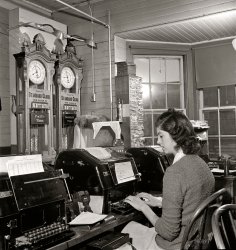
- Super Chief: 1943
- ... size.
Wow This is EXACTLY how I want my model railroad to look like!
yep I toatally agree execept mine will be built ... earplugs on our pillows. Necessary, because of the train yard immediately behind the hotel.
The hotel was almost torn down, and the ... Posted by Dave - 07/29/2024 - 9:58pm -
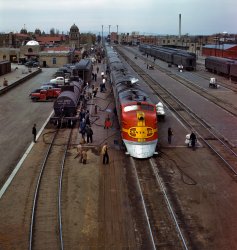
- Galewood Yard: 1943
- April 1943. Galewood Yard of the Chicago, Milwaukee, St. Paul and Pacific Railroad (Milwaukee Road) at Chicago. View full size (if you don't, you're ...
War Information (OWI). His work can be found in a great railroad book, the "Iron Horse at War" (out of print).
Delano railroad ... Posted by Dave - 08/05/2012 - 9:27am -
![Galewood Yard: 1943 April 1943. Galewood Yard of the Chicago, Milwaukee, St. Paul and Pacific Railroad (Milwaukee Road) at Chicago. View full size (if you don't, you're missing a lot). 4x5 Kodachrome transparency by Jack Delano.
This was probably one ofThis was probably one of thephotos Jack took during a survey of american railroads during WWII for the Office of
War Information (OWI). His work can be found in a great railroad book, the "Iron Horse at War" (out of print).
Delano railroad photosHi Jeff,
Actually, a better place to find the Delano images is to head straight to the Library of Congress' website and doing a search for "Jack Delano". YOu want a full sized image? How about a 200 meg TIFF?
[You won't find anything on the LOC site like our full-size version of the image above. Plus, the LOC images are all uncorrected.- Dave]
RR yardGreat pict, Milw RR had some huge yd in Chicago, of interest would be how they unloaded & loaded the boxcars accross 5 tracks without platforms inbetween them, I bet they used ramps inbetween the cars so they could access them and save a lot of money on constucting many platforms. The cars would be spotted (placed) so the doors would line up with all 5 tracks. Just make sure the switch yd crew would do a good job of lining the cars up. I like the Alton car which looks just recently painted. I wonder if any of this yd is still around.
Galewood YardYes the yards are still there....or were a year ago. I retired from CMSt.P&P RR...I hired out on the Southeastern Division and later transfered to the D&I and worked the suburban trains that ran right past theese yards. and you were correct about ramps...they bridged the distance with very hweavy constructions that were set in plase with forklift.
(The Gallery, Kodachromes, Chicago, Jack Delano, Railroads)](https://www.shorpy.com/files/images/1a34816u.thumbnail.jpg)
- Blue Island Yard: 1943
- January 1943. Riverdale, Illinois. "Blue Island Yard of the Indiana Harbor Belt Railroad with view of the icing platform." Photo by Jack Delano, Office of War ... Posted by Dave - 04/15/2024 - 1:33am -
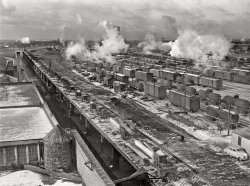
- Cafe Society: 1943
- ... RR? The guy looking into the camera appears to wear a railroad cap. I wonder if this is near the Santa Fe yard off Central Ave.?
(The Gallery, Albuquerque, Eateries & Bars, John ... Posted by Dave - 07/29/2024 - 9:57pm -
![Cafe Society: 1943 February 1943. "This image in a jacket marked 'Killed'." From photos taken in and around Albuquerque, New Mexico, by John Collier for the OWI. View full size.
Bar looks pretty well stocked.Might be 1943, but no shortage of beer and peanuts.
GodlessThe pledge of allegiance, before "under God" was added, hangs on the wall.
One Bourbon, One Scotch, One BeerNow that's what I call a bar. I bet it's heaving on a Friday night.
C'mon, Burquenos!Someone in my favorite city must recognize this place. It's time for Shorpy sleuths to leap into action. First clue: If the back wall is right, it's "Cafe [something]."
My kind of jointNo foo-foo drinks with straws there.
No martinis made with apple flavoured vodka either.
Sippers vs. SluggersYou can tell how a fellow drinks his beer by observing the foam rings left inside the glass every time he takes a drink. A sipper nurses his beverage, savoring the amber current flowing through his mind. The guy with the glasses facing the camera, center frame, is a sipper. If you zoom in you can plainly see three, maybe four foam lines closely spaced with a third of his glass empty. Perhaps he's short on cash and wanting to prolong his evening at the bar before returning home to the missus. A sipper sacrifices the crisp pop of a whole glass of cold beer on the belly and brain for the lingering pleasure of standing at the bar in the company of friends and neighbors
The gentleman looking straight at the camera with his cap pushed back is a slugger. Notice how his glass is also about a third sailboat fuel. One thick foam line tilted ever so slightly to the rim indicates he drained a third of his beer in two big gulps. Ahhh! Now that's refreshing!
Ol' Goober employs both tactics -- slug one, then sip one, slug one, sip one ... lather, rinse, repeat.
OverheadThe light fixtures are a schoolhouse pendant.
An observationDoggone, but that Gooberpea is an entertaining (and accomplished) writer!
Re: Sippers vs. SluggersWonderful analysis of the beer glasses. One of my all-time favorite Shorpy comments. Well done, Gooberpea! Best line: "A sipper nurses his beverage, savoring the amber current flowing through his mind." Close second: "A sipper sacrifices the crisp pop of a whole glass of cold beer on the belly and brain for the lingering pleasure of standing at the bar in the company of friends and neighbors." Pure poetry.
Santa Fe RR?The guy looking into the camera appears to wear a railroad cap. I wonder if this is near the Santa Fe yard off Central Ave.?
(The Gallery, Albuquerque, Eateries & Bars, John Collier)](https://www.shorpy.com/files/images/SHORPY-8d26247u.thumbnail.jpg)
- Proviso Departure: 1943
- ... yards at Chicago & North Western RR's Proviso Yard." 4x5 Kodachrome transparency by Jack Delano for the OWI. View full ... effort.
Proviso Yard Great photo. Amazingly, as railroad locations go this location is remarkably similar today -- Proviso Yard ... Posted by Dave - 07/30/2012 - 10:04pm -
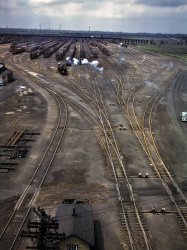
- The North Yard: 1942
- ... Illinois. General view of the north classification yard at an Illinois Central railyard." Acetate negative by Jack Delano, Office ... right, is a man walking the tracks. Beyond him, where the railroad cars are, I count 10 men walking (I'm pretty sure they're all men).
... Posted by Dave - 01/11/2024 - 1:36pm -
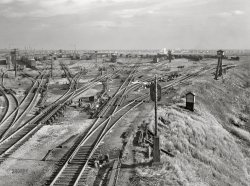
- Yard Cop: 1942
- ... refinery, Tulsa station of the Great Lakes pipeline. Armed railroad guard inspecting an oil tank car in the yards." Medium format acetate ...
The trusty Winchester I've seen pictures of the yard cop with a night stick. Winchester is the baseball bat. I guess for the ... Posted by Dave - 12/04/2023 - 11:27am -
![Yard Cop: 1942 October 1942. "Tulsa, Oklahoma. Mid-Continent Petroleum Corp. refinery, Tulsa station of the Great Lakes pipeline. Armed railroad guard inspecting an oil tank car in the yards." Medium format acetate negative by John Vachon for the Office of War Information. View full size.
The trusty WinchesterI've seen pictures of the yard cop with a night stick. Winchester is the baseball bat. I guess for the war effort and saboteurs?
Changing job focusA few years earlier the railroad yard cop would have been after hobos; movies of the 1930s have many such scenes. By 1942, war and economic activity had largely solved the hobo 'problem'. Now the concerns were sabotage, theft of raw materials, and security in general.
The Case of the Missing Journal LidSomeone obviously pilfered it! The oil-filled journal box should have a snug-fitting cover, as seen on the one at far left, to keep rain water and road dust out of the bearing area. The journal box closest to the gun-toting lawman seems to have taken its leave?
Black and White HeatA rifle ... next to an oil tank(er)??? Guess he didn't see the movie (But he had a good excuse: it wouldn't be released until seven years later)
Vintage graffiti?I hadn't thought about graffiti in 1942. But then why not. Much less ugly than spray paint!
[Those are yard-crew markings. - Dave]
How StylishIn a three-piece suit & tie complete with handkerchief, this fellow seems quite overdressed. Railyards (especially in the days of steam locomotives) were very dirty places. Bib overalls would have been more appropriate. Maybe he spends time in an office or just wanted to look good for Mr. Vachon's camera.
(The Gallery, John Vachon, Railroads)](https://www.shorpy.com/files/images/SHORPY-8d44981a.thumbnail.jpg)
- Hybrid EV: 1942
- ... "Chicago, Illinois. One of the Chicago and North Western Railroad streamliner diesel electric locomotives. These trains are operated ... don't charge or operate on batteries (except some at low yard speeds for shuttling).
[You're thinking about this much too ... Posted by Dave - 03/10/2024 - 2:58pm -
![Hybrid EV: 1942 December 1942. "Chicago, Illinois. One of the Chicago and North Western Railroad streamliner diesel electric locomotives. These trains are operated jointly with the Union Pacific Railroad to the West Coast." Acetate negative by Jack Delano, Office of War Information. View full size.
Not hybrid or EV.Locomotives are diesel-electric, not hybrid. The electric part is the method of power transmission between the engine and wheels because they have a 250-950rpm operating range. A gearbox would be too large and complex to be practical, especially when synchronizing multiple units. They don't charge or operate on batteries (except some at low yard speeds for shuttling).
[You're thinking about this much too narrowly. Hybrid: "Of mixed character; a thing made by combining two different elements." - Dave]
Ice BeardJust like old man winter.
Chug and playShorpy is certainly correct - but then almost all (North American) "diesels" are such: a diesel engine drives a generator that powers the traction motors. But the U.P. was strictly an amateur about combining powering methods
The SBB lok is still around - ! - but converted back to free-range capabilities.
EMD E6It looks like the EMD E-series, guessing E6, built from 1938 to 1942.
I take it backThe E-series didn't have the radiator. Lionel offered two streamliners, the M10000 and this thing. I can't find pictures of this thing that also give the model number.
Achoo-choo!It looks like its nose is running! I love that streamlined look, though. I'll bet it's sporting that striking Union Pacific armour yellow and gray paint scheme, too!
Re: Achoo-choo!You are absolutely correct!
Not an E-unit. It's an M-10000!I think that the "runny nose" comes from water in the air hoses. (Just a guess!!)
Steam HeatPassenger cars of the past used steam for heating and, in some cases, for air conditioning too. Steam locomotives had plenty, but diesel electric locomotives needed diesel oil fired auxiliary boilers. The steam is transmitted from locomotive to cars via metal pipes and couplings. In freezing weather, it seemed one could always see whisps of steam here and there - perhaps the valve beneath the pilot (steel plate above the rails) was slightly cracked open to prevent freezing. Once can see minor damage to the pilot - perhaps the locomotive encountered a vehicle somewhere at a crossing.
Only a handful of these machines were built before larger and more powerful locomotives became available. I recall reading that one of these locomotives struck a skunk which splattered over the area where we see the frozen steam. The large, automobile-like grilles, supposedly brought the odor into the cab making things stinky for the crew.
About that runny nose.Water is never permitted in a trains air hose. A frozen brake line is a train wreck looking for a place to happen.
Passenger engines such as this one have (had) a steam generator on board to supply a steam pipe to the entire train for heating, air conditioning, cooking, etc. The ice on the pilot would be condensate from this steam line.
Corrections (for those who care)This locomotive is a Pullman-Standard M-10005 or M-10006, produced in 1936 -- a descendant of the "original" M-10000 from 1934, which was already retired a year when this photo was taken. These were predecessors of the famous EMC/EMD "E" series locomotives produced by EMD starting in 1937.
Additionally, the icicle "beard" was caused by leaking steam from the steam train line -- steam was used to heat (and cool in summer for coaches that had steam-ejector air conditioning installed) the passenger coaches, and was produced by steam boilers on the locomotive. Steam was used on all conventional passenger equipment until the late 1970s when electrical head-end-power (HEP) came into vogue.
(The Gallery, Chicago, Jack Delano, Railroads)](https://www.shorpy.com/files/images/SHORPY-8d11464u.thumbnail.jpg)
- Washington Yard: 1917
- ... shippers using their own "teams" (as in teamsters) without railroad employee assistance. Team Tracks were ubiquitous in the pre-highway ... here quite a lot (probably because Tucson has a large rail yard and some of the film was shot here), and I always find myself getting ... Posted by Dave - 08/28/2012 - 5:59pm -
![Washington Yard: 1917 Washington, D.C., circa 1917. "U.S. Capitol dome from rail yards in Southeast section." Harris & Ewing Collection glass negative. View full size.
Dangling thingsPlease tell me what the dangling things are off of the pole in the left center of the picture and what purpose they served.
[Overheight telltales for any brakemen on top of the cars. To let them know that a bridge, tunnel etc. is coming up. - Dave]
Fallen FlagsI find it very interesting that out of all of the railroads represented by these freight cars only the Florida East Coast still exists with the same name.
Team TracksThe brick paving and the variety of railroads represented leads me to believe these are what were known as "Team Tracks," or "Public Tracks," meaning cars (mainly boxcars) were spotted on them for loading and unloading by shippers using their own "teams" (as in teamsters) without railroad employee assistance. Team Tracks were ubiquitous in the pre-highway era, and they didn't completely disappear until around 1970. A large percentage of carload freight shipments were handled this way. The shipper obtained a lower rate, and you were not required to have your own rail spur ("Private Track").
This service was available to anyone, including individuals. When my great-grandparents were moving between cities in the early 1900s, they ordered a boxcar to be placed at a local Public Track, arranged to have their household belongings loaded into it, and then reversed the process at another Public Track at their new town of residence. Of course, for more prosperous clientele, moving or transfer companies would take care of all that for you, and such companies probably would have their own warehouse and private tracks.
This was how transportation worked before paved roads.
For train loversThis doesn't have much to do with this photo specifically, but I think the train enthusiasts who are likely to like this picture will also very much enjoy this link.
This is a sort of documentary made in the 40's about the Southern Pacific Railroad. It gets shown on a cable access station here quite a lot (probably because Tucson has a large rail yard and some of the film was shot here), and I always find myself getting sucked into watching it when it's on.
"This Is My Railroad," Part 1:
http://www.archive.org/details/ThisIsMy1940
Part 2:
http://www.archive.org/details/ThisIsMy1940_2
It's a great record of the attitudes and mindset of the period (though it comes across as laughably sexist at times!).
Southern Railroad yardsThis is the Southern RR yards located in the Southwest section of DC. The view of the Capitol is the West Front with the Library of Congress dome to the right of the Capitol. The passenger line from the south ran under the mall in front of the West Front of the Capitol to Union Station
Horse headPeeking out at the very end of the longest line of freight cars. Maybe there to take a load of something off the waiting cars.
Making a mark on societyThankfully, the spray can hadn't been invented yet.
Ninth and DThis would not be the Southern yards, which were in Alexandria. This is a small PRR (I believe ex-B&P) yard that occupied the land bordered by Ninth and D streets SW. This Google Street view is as close as one can get to the photographer's vantage looking north east. By the time of this photo, Washington Union Station had been open for nine years. The passenger train is headed that way on the present elevated alignment which was built concurrent with Union Station.
View Larger Map
About the B&P RailroadWhile I don't think the yard pictured was owned by the B&P, that railroad did have facilities nearby at one time. Attached is a bit of an 1886 map showing the pre-union station arrangements. Note the B&P station between 6th and 7th streets on the north side of the mall. An d of course, the B&P did eventually become part of the PRR.
The yard in the photo is in th eblock marked 386, right at the left edge of the map snippet.
About those dangly things and ownershipI sinned, in that I submitted a too wide image. This is a repeat of the message, with a suitably edited copy of the image. I apologize.
I found a panoramic drawing on the Library of Congress web site, dated 1921 which shows the area in question, but looking in from the east south east, I've attached an snippet from that view.
I believe the photographer was standing on the 10th Street SW overpass, and that bridge was the reason for the telltales seen in the photo.
As to the owner of the yard/team tracks, the panorama marked the tracks approaching the area as "Southern Railway System." Look between 6th and 5th streets. There is another such notation just out of the frame on the top.
The dome peeking out between the bare tree and the three story building appears to be the Library of Congress building, what they now call the Thomas Jefferson Building.
SwaybackMost of the boxcars in this picture had wooden frames. To help support the center of the 40' long cars, two to four metal rods were run between the ends and below "queensposts" at the center of the car. The rods were called truss rods as they provided support similar to the trusses of a bridge. One rod is visible below the "Georgia" car. The rods had turnbuckles at their centers to provide some adjustment of their tension. Many years of heavy loads and hard use overcame even the ability of the truss rods to defy the law of gravity, and cars gradually developed the swayback appearance seen here. Iron, and later steel, underframes and sides eliminated the sag in all but the most abused cars.
Model railroaders who model this period spend many hours building that sway into brand new models.
(The Gallery, D.C., Harris + Ewing, Railroads)](https://www.shorpy.com/files/images/10149a.thumbnail.jpg)
- The Hump Master: 1942
- ... 1942. "Hump master in a Chicago & North Western railroad yard operating a signal switch system which extends the length of the hump ... Posted by Dave - 03/20/2024 - 11:24am -
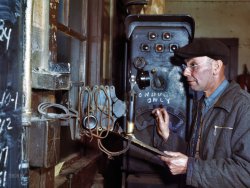
- Ebby's Diner: 1942
- ...
The Old PRR Main Line The original Pennsylvania Railroad main line passed through Lancaster right through the downtown area. ... near the western end of the Norfolk Southern Lancaster yard. The tracks crossed Harrisburg Avenue west of the new stadium and ran ... Posted by Dave - 02/25/2024 - 3:47pm -
![Ebby's Diner: 1942 February 1942. "Lancaster, Pennsylvania." Ebby's Diner and the Corine Hotel at Queen and Chestnut streets. Photo by John Vachon for the Office of War Information. View full size.
Trolley 236 still runningLancaster had a city streetcar system and an extensive electric interurban railway service in the area. It lasted until 1947 when buses replaced the trolleys. Birney car 236 still runs in nearby Manheim, and you can learn all about it in this video. John Vachon's street views from above really capture that moment in time.
Delicious geometriesCertain photos on this website work their magic immediately and then leave me to try to figure out where the power comes from. First to spring out at me are the pleasing geometric planes, forming a big Z in the middle, with the streetcar tracks acting as the central diagonal. Then there’s Ebby’s Diner, which appears like a larger version of those two streetcars. And the allure of those cozy establishments -– how I wish I could go to eat at that diner or The Village restaurant or even Sprenger’s, whatever kind of place that is. And winter! Bravo, John Vachon.
Here and GoneThe diner is gone. It would have been to the far right facing Chestnut. The hotel is gone too. It would have been where the parking lot is now. The three-story brick building remains with some modifications. The commercial ground-floor space was removed.
Great photo!What a great photo!
WowEchoing @davidK, this photograph is a masterpiece.
Whazzat?Is that a lumberyard in the upper right? It’s an unusual open-sided structure
The Old PRR Main LineThe original Pennsylvania Railroad main line passed through Lancaster right through the downtown area. The depot was located at Queen and Chestnut Streets. You can see a boxcar under the roof where the original depot once stood. Apparently by this time the track had been terminated here and that boxcar is now sitting in what would probably be a covered team track. A study of satellite views will reveal parts of the old right-of-way and some buildings cropped at odd angles or others that were once parallel to the tracks.
[update]
Upon finding maps of Lancaster circa 1900 I have concluded that the actual PRR trackage passed right across the lower portion of the photograph frame and, indeed, Ebby's Diner is perched directly on the former right-of-way. The box car further down E. Queen St. is actually on a stub-end siding that once served a business there or could have been a freight house.
Ebby's Was The Old Pennsy RR StationI could be turned around, but I think the view faces northwest, in which case the train station was on the lot where Ebby's stands in this photo. The tracks came into Lancaster from the N.W. and crossed the empty lot next to (left of) the Hotel Corine, then across Queen Street to the passenger station. The beginning of these tracks are visible from Dillerville Road (or on Google Maps) near the western end of the Norfolk Southern Lancaster yard. The tracks crossed Harrisburg Avenue west of the new stadium and ran into the center of town. The boxcar under the shed was one of many stub tracks that branched into small sidings. Bits of the right of way were turned into parkland or create strange property lines that are still visible, as G of V noted. The tracks then continued east and north to rejoin the main line.
Also goneis the building from where John Vachon took this photograph. If you swing around in the Street View supplied by kozel, there's a Holiday Inn there now. No doubt it was a cold February day in Lancaster, yet two windows at the corner hotel (I can't read the name) are open. On the top floor one is open a little. The window directly below it is wide open. Brrrrrr.
This Photo Smells So GoodMy mouth is watering, what with the cooking smell coming from the diner and the cold frigid air that carries the smells of the bacon and eggs, or steak and potatoes to your olfactory senses.
The hotel might have a place to eat as well, if so, that would overload the senses with its waft of whatever is non the grill.
Another odor would be the scent of freshly laundered sheets and/or towels from the Laundry at the top left of the picture.
A-lone survivorBuilt like a brick shi... er, well, solid as a rock. Probably good for another coupla hundred years.
About those open windowsDoug (see below) pointed out that on an obviously chilly day, a couple of the windows in the hotel are open. Back in the day it was a routine practice for housekeeping to throw open windows in recently vacated rooms to air them out. This would have been especially desirable in an era when smoking was so common, even in hotel rooms. Also, most hotels did not have individual thermostats in rooms to control the heat. The heat was typically from radiators or from ventilation grates in the floor connected to an often coal fired furnace. In either case, the heat was usually controlled by the hotel staff. Sometimes rooms could get a bit stuffy or just plain hot, to the point where even on a nippy day, cracking a window for a few minutes might be the only way to get some fresh air and cool off.
Lancaster's Pennsy StationI found this early view of the Pennsylvania Railroad Station courtesy of the Lancaster County Historical Society.
Sometimes It May Not Have Smelled So GoodThe Lancaster Stockyards, the largest stockyard east of Chicago, was located about a mile north of here along the PRR mainline between Philadelphia and points west. It handled 10,000 cattle a day, along with pigs, sheep and other animals arriving by rail from the west. After a layover, the doomed animals boarded connecting trains and were distributed to other cities to meet their fates. If the wind was just right the scent of bacon and steak on the hoof may have tainted the wonderful odors emanating from Ebby’s and The Village.
142 units, 12 stories, $7,556 per mo.The site of the former Corine Hotel, shown as a parking lot on Google Street View, is currently a construction site for a market-rate rental development, scheduled to be finished by late spring 2024.
[$7556 is the rental rate for the first-floor retail/restaurant space. - Dave]
More Open WindowsI can definitely related to Ad Orientem's comments on heated hotel rooms.
To paraphrase Mark Twain, the hottest Summer I ever spent was a Winter's night in Moscow!
We spent several nights in Moscow's Hotel Ukraina back in January, 1998. Imagine sleeping in underwear, on top of the bed, with the floor-to-ceiling (unscreened!) windows open to try to catch a breath of breeze. Under 10F outside, and over 80F inside, with no way to regulate the steam heat!
The downside of free city-wide steam.
Closed?The diner shows no signs of life that I can see. Can anyone read the sign on the door?
[All those footprints would seem to indicate otherwise. - Dave]
Man in BlackExceptionally composed photograph. To my eye the man in black along the roadway is the focal point. The angles lead to him. I am always amazed by snow scenes, the intensity of reflected light, which even on a cloudy day usually requires a small aperture with attendant great depth of field and sharpness.
(The Gallery, Eateries & Bars, John Vachon, Streetcars)](https://www.shorpy.com/files/images/SHORPY-8d12447a.thumbnail.jpg)
- Red Comb Feeds: 1943
- ... Illinois. "Freight operations of the Indiana Harbor Belt Railroad. Grain elevator and mill at a siding of the Harbor Belt's Blue Island Yard south of Chicago." Medium format acetate negative by Jack Delano for the ... Posted by Dave - 04/13/2024 - 9:40pm -
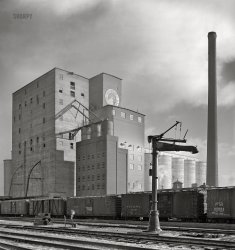
- Navy Yard Newsies: 1903
- Circa 1903. "Sands Street entrance, Brooklyn Navy Yard." With a flock of newsies, and Lewis Hine nowhere in sight. Detroit ... from a very short line called the Jay Street Connecting Railroad. It switched freight cars between buildings and the piers.
+101 ... Posted by Dave - 08/20/2012 - 9:53am -
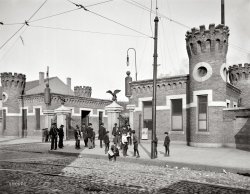
- Icing on the Freight: 1943
- ... January 1943. "Icing platform of the Indiana Harbor Belt Railroad. Blue Island Yard south of Chicago." Acetate negative by Jack Delano for the Office of War ... Posted by Dave - 04/17/2024 - 2:26pm -
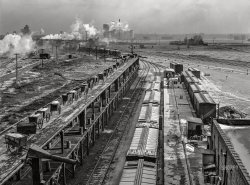
- The Hump Master: 1942
- ... Illinois. Hump master in a Chicago and North Western Railroad yard operating a signal switch system which extends the length of the hump ... Posted by Dave - 03/20/2024 - 11:27am -
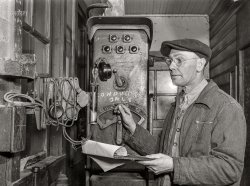
- Nashville: 1864
- 1864. "Nashville, Tennessee. Rail yard and depot with locomotives." Wet-plate glass negative by George N. ... View full size. Another view here .
This Railroad Terminal is not eligible for the Good Housekeeping Seal of ... hence the gathering of so much here.
Nashville Railroad Yard in 1864 by Bernard The State capitol building in the upper ... Posted by Dave - 07/17/2012 - 10:26pm -
![Nashville: 1864 1864. "Nashville, Tennessee. Rail yard and depot with locomotives." Wet-plate glass negative by George N. Barnard. View full size. Another view here.
This Railroad Terminalis not eligible for the Good Housekeeping Seal of Approval.
Less is MoorishWhat bizarre architecture! That sagging entry portal is being held up with that one flimsy pole? And the archways look Persian or Turkish or "Arabian" while the turrets look like an English castle. The whole thing looks like it's going to fall apart any minute. I'm afraid Nashville here looks like Atlanta post Sherman!
Where's Buster?Great RR view...but I kept looking for Buster Keaton peeking out of one of the locomotive cabs, or sitting on a connecting rod kissing his girlfriend!
Perspective is an odd thingThose huge chunks of wood make the engines look tiny, even though I know they aren't. I also like the ghostly image of the now long-dead man in the shack. It's a rare treat to look back 100+ years into the past and I'm still amazed at the clarity of these old photographs.
Music CityThis shot was taken where the bulk of downtown Nashville now resides. You can see the state capital off to the right. Even today Nashville is a pretty small city. Growing up not far from there, it always amazed me that such a smallish city could have such clout in the world of country music.
NashvilleThe building that you see in the upper right hand corner of the photo is the state capital. It was completed only a few years before the beginning of the war in 1861. It still stands today.
Nashville fell to Union forces without a fight in February of 1862. However, in the fall of 1864, in a last ditch effort to relieve the pressure on General Lee's forces in Virginia, confederate president Jefferson Davis ordered confederate General Hood to disengage from following Sherman to the sea and attack Nashville and after its capture move into Kentucky and then Ohio in hopes of the Union suing for peace. So, on December 15th and 16th of 1864 Union forces came out of their dug in positions and attacked Hood who had over the two proceeding weeks dug in and waited for the Union forces of General Thomas. Then over those two days Union forces soundly defeated the confederate forces.
WOW....What an incredible photo, and could be of great use to model railroaders doing that era. The wood clutter would be almost impossible to manage due to the amount of engines and all burning wood....I guess there was no forest management in those days either. As a Canadian I must ask what USMRR stands for.
CrenelatedThe "crenelated" appearance could easily be a Moorish or Spanish-Moorish influence. They weren't just "English castle" style but really pretty universal.
Telegraph linesThe timbers on the the crenelated corner towers (chimneys?) do look like rail ties, but they have been fitted with prong-like pieces of wood and ceramic insulators for telegraph lines. Some of the lines themselves can be seen running from the insulators on the front corner tower to the insulators on the scaffolding at the center back roof parapet, and to another timber with three insulators on the tower at the far back corner of the building. All of this looks like an ad hoc arrangement, perhaps the result of a wartime need for more telegraph lines than were needed for a peacetime rail depot, or to quickly replace lines that were downed when the brickwork was damaged.
Up thereOkay, I've got to ask. What are those things sticking out of the "turrets"?
[They look like sections of track, complete with ties. - Dave]
Nashville DepotThis depot was on McLemore Street. This Google view is pretty close. Those might be the same bricks in the 1864 photo.
View Larger Map
USMRR>> As a Canadian I must ask what USMRR stands for.
The answer can be found here.
CamouflageI looked at the full-size picture for quite a while before I realized that there are two workers sitting in front of the woodpile.
Pony truck journalsPlease note the external journals on the pony truck of the lead engine nearest the camera. That's something you did not normally see on steam engines until the the twentieth century and then not until the "twenties" and then it was unusual. C&NW 4-8-4s had 'em. A few others too. Interesting! In 1864.
USMRR I am sure the meaning of USMRR means United States Military Rail Road. Rolling stock and engines were valuable for transportation during the Civil War. Far faster than horses capable of 40 to 50 MPH for long periods, the US government during this time depended on rail transportation. Nashville was a hub for the South plus it's Cumberland River traffic, hence the gathering of so much here.
Nashville Railroad Yard in 1864 by BernardThe State capitol building in the upper right orients you pretty well as to where Bernard took the Photo. Although the depot buildings are long gone, the RR yard is still there, although probably not for very long--the neighborhood is getting very posh now and CSX Railroad is sitting on valuable real estate.
It is called the Kaine Avenue Yard and the rsilroad still uses it, mainly for trains passing through the city (the ones staying go on to the huge Radnor yards). In the 1890's they built Union Station adjacent to the tracks--approximately where the lower right of the photo would be. The center of the Yard lies just below the Demumbreun Street Bridge on Eleventh Avenue; Bernard probably took the photo a little ways up the hill, around Twelfth, likely across the street from where a strip club now exists. The photo was probably taken sometime around the battle of Nashville, but there are only a couple of shots of the Union battle lines and none of any action. Bernard preferred buildings to people. FYI
(The Gallery, Civil War, Geo. Barnard, Nashville, Railroads)](https://www.shorpy.com/files/images/02112a.thumbnail.jpg)
- Garden State: 1939
- April 1939. "Rail yard. Newark, New Jersey." Medium format negative by Arthur Rothstein for the ... County Extension bridge will be just to the right of the railroad drawbridge. The Chemical Coast branch runs from right to left in the ... Oak Island yard I posted a link to the photo over at a railroad message board to which I belong, for the purposes of identifying the ... Posted by Dave - 11/29/2017 - 12:17pm -
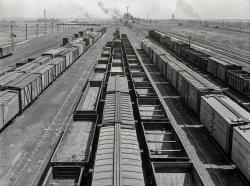
- Old Ferry Lane: 1910
- ... Publishing Company. View full size.
Kittery in railroad lore Railroad fans know of Kittery because it is home to the least ...
Kittery Shipyard rail move They did a move to the yard back in September. Here is a video from a rail move last year:
... Posted by Dave - 10/21/2023 - 4:51pm -
![Old Ferry Lane: 1910 Circa 1910. "Old Ferry Lane -- Kittery Point, Maine." 8x10 inch dry plate glass negative, Detroit Publishing Company. View full size.
Kittery in railroad loreRailroad fans know of Kittery because it is home to the least active rail line in the country. The line goes to the Portsmouth Naval Shipyard and averages two trains, of just a few cars each, per year. Rumor has it that they carry radioactive waste from submarines to disposal sites in Idaho, but the Navy won't say.
A Nice WalkFound the spot the photo was taken! Looks like the house is still there as of 2017.
Just love this old photo, makes me want to walk down that dirt road on a nice summer day with my dog.
Kittery Shipyard rail moveThey did a move to the yard back in September. Here is a video from a rail move last year:
There's a signpost up aheadWe see the small sign, Old Ferry Lane, at right. But, past the branches, there is another sign for those headed in this direction. It's a much longer sign. I wonder what it says?
["I'M ACTUALLY A FENCE"? - Dave]
This could be the house.
The trail of evidence suggests ...This view seems to be close to the spot in the original image.
The stone wall in the original has been lowered and smoothed over in the current view. But the mall cape in the distance has the same dormers looking out over the roofline, and the outcrop of stones along the edge of the driveway today is also present in the original image.
Sure does seem like the spot. I've commented earlier that "things don't change much in New England." Even more of a truism in coastal Maine.
Bicycle tracks?It looks like there are more bike tire tracks on that road than anything else.
[Um, those are wagon tracks. - Dave]
The Box on the Pole:What is the box used for? Just local messages to people in the neighborhood?
Box on the pole:Judging by the porcelain knob and electrical wires running to the box, my guess is there's a switch in the box to turn on a light at the top of the pole.
That box is wiredIn addition to being padlocked, the box on the pole has two wire connected to it. One passing around a ceramic insulator and then goes up the pole passing yet another insulator. Another goes straight down to the ground from the bottom of the box. I'd guess this means it's its power and the box may be a junction box or fuse box.
Re: Box on poleThat appears to be a single wire telephone. The wire coming down the pole goes into the phone while the wire at the bottom completes the circuit using earth return. OK for short hauls but the noise level increases rapidly with distance. Probably a dedicated service customer protected with padlock.
The WallInstead of the stone wall having been shortened, I'd think the more likely scenario is that the level of the road has been graded and raised, obscuring the lower portion of that cement capped stone wall. Great photos.
(The Gallery, DPC, Landscapes)](https://www.shorpy.com/files/images/SHORPY-4a23484a.thumbnail.jpg)
- Boilermakers: 1942
- ... on which they have been working in the roundhouse at a yard of the Chicago and North Western Railroad." Acetate negative by Jack Delano for the Office of War Information. ... Posted by Dave - 03/17/2024 - 3:57pm -
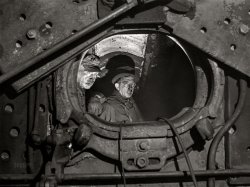
- Pabst Over Chicago: 1943
- ... "South Water Street freight depot of the Illinois Central Railroad, Chicago." 4x5 Kodachrome transparency by Jack Delano. View full ... to the track. Also, note that several of the cars are on "yard air" in order to test the brakes on each car prior to movement. Finally ... Posted by Dave - 05/07/2017 - 2:11pm -
![Pabst Over Chicago: 1943 May 1, 1943. "South Water Street freight depot of the Illinois Central Railroad, Chicago." 4x5 Kodachrome transparency by Jack Delano. View full size.
DirectionalityI believe this photo is facing north. Quite a few of the skyscrapers are still there. All the way to the left, the black & gold building is the Carbide & Carbon (or is it Carbon & Carbide?) building on Michigan Ave. I seem to remember something about it being the "first" skyscraper. Just to the right, with the little cupola on top, is the original Stone Container Building at Wacker & Michigan Avenues. Off in the furthest distance in the center of the photo you can see what was originally called the Pamolive building (it became Playboy Towers, and is now a condo building). I think the building behind the Pabst sign at the right edge of the sign is the Chicago Tribune building, and across from it (underneath the main part of the sign) you can see the white building that is the Wrigley building. They flank Michigan Ave. just north of the Chicago river.
Fellow (ex-)ChicagoanDefinitely facing North, definitely the Carbon & Carbide building - my dad used to have an office there. Not sure about the Playboy Towers.... might that be the Drake Hotel?
33 to 1?Blended 33 to 1? That sounds like a strange formula to me...but of course I'm not informed on the whole beer and beer history thing.
33 to 1Here's a 1940 Pabst ad that explains it.
NorthThere is no question about it, this photo is facing north.
Good Railroad ShotThe blue flags placed on the cars would be a violation of federal regulations today as they now have to be located at the switch providing access to the track. Also, note that several of the cars are on "yard air" in order to test the brakes on each car prior to movement. Finally you can see that this photo provides good images of several different types of car ends all together in one place.
As I am from Milwaukee, I have no clue as to which buildings are which! I do know that the photo is definitely facing north as I now work for the South Shore commuter railroad and am familiar with the lakefront. I also know that the original Santa Fe railroad corporate headquarters was almost directly to the west of this photo and is still there today with the Santa Fe sign on top. It is now an historic landmark.
Bootcamp BeerI went to Navy bootcamp in Great Lakes Il. in 1983 and after spending 10 wks. without beer our first chance to have a brew came. Unfortunatly for me the ONLY beer avaliable to us at the time was Pabst Blue Ribbon. Now, not being a Pabst fan I was very unhappy about that but after 10 tough weeks I said "what the heck" and ordered a couple of beers. I'll tell you what, that was the best beer I've ever had. I got so drunk the rest of the day was blur. I'd like to say "Thanks you Pabst" for the best beer ever and day I don't remember.
Water Street DepotIt appears we are looking north from either Monroe or Randolph. I want to say we're looking from Monroe and that bridge spanning the width of the pic under the sign is Randolph. The row of low-rise buildings on the left side of the pic that are ~6 stories tall and have the water towers on top of them would then be on the east side of Michigan Ave and sitting directly on the north side of Randolph. I believe these trains are in the area east of Michigan Ave and north of Monroe, but south of Randolph as it used to be a railyard (now Millennium Park, north of the Art Institute).
Furthermore there were never any buildings previously on this spot, as it would have either been a rail yard or part of Grant Park (where no buildings were allowed to be built, except for the Art Institute). This leads me to believe that we are looking north from Monroe towards Randolph and beyond. The vast empty space behind the Pabst sign spanning the whole width of the image would now be occupied by Illinois Center, the Prudential Building and of course the tall white AON Building (3rd largest in Chciago at the moment), or whatever they call it these days.
Pabst SignCan anybody tell me if this sign was was animated and are there any night time shots of it?
[The nighttime shot of this neon sign is here. - Dave]
AnimationThanks Dave, do you know if the sign was animated in any way?
[The hands on the clock moved! If you mean did various parts of the sign blink on and off, I don't know. - Dave]
ChicagoI see the tallest building to the far left when I'm going to and from school. It's surrounded by a bunch of other buildings now.
Chevrolet SignThis is a film clip of another Chicago sign. It shows how animated signs were operated. I can't find any date, but the technology looks like 1940 or so.
http://www.encyclopedia.chicagohistory.org/pages/410104.html
Chevrolet SignAfter viewing this clip of the Chevy sign, I'm fairly convinced that it and the 'Pabst' sign are one and the same. Shown in the clip of the Chevy sign is the same tall building that is located to the left of the Pabst sign in the photo. There are other similarities as well, like the circular design of the sign, the clock at the lower right, etc. It's my guess that Pabst took over the sign after Chevy and made the slight changes to suit their logo.
South Water Street TodayThis photo is facing North on South Water Street and intersecting roughly what is now Columbus Drive. The ground level of this photograph is now covered by an elevated roadway in this area. If you went to this spot today, the Pritzker Pavilion at Millennium Park designed by Frank Gehry would be just behind you.
The Playboy Building is visible in the background, now once again called the Palmolive Building and converted to condominiums. It sits between the Drake Hotel and John Hancock Tower at the end of the Magnificent Mile. The Drake is not tall enough to be in view here.
The Allerton Hotel and Northwest University Law School in Streeterville are also visible here, which they wouldn't be today from the site, although they are still standing.
Several of the mid-rise buildings in this photograph are no longer standing, in particular the large red-brick warehouse at the center mid-ground, to the right of the Playboy/Palmolive. This is where the NBC Tower now stands, just north of the river.
Driving and DrinkingThis was indeed the Chevy sign. Pabst took it over. You can still make out the Chevy logo in the superstructure of the sign. The lower left hand corner of the "B" in Blue and the upper right hand corner of the N in "Ribbon" served as the edges of the classic Chevy "bowtie" logo.
Going to ChicagoIt's interesting to think that Muddy Waters would have just arrived in Chicago when this photo was taken.
Pabst signThe Pabst sign was next to Randolph Street Bridge; refer to the 1922 Zoning map that is available at the University of Chicago library site - the Illinois Central may very well have called the yard the 'Water Street Yard,' but Water Street moved to the South Side when Wacker Drive was created after 1924; the Pabst sign was located nearest the Randolph Street bridge and is the current location of the Prudential Building, not the Pritzker Pavillion.
Warehouse full of booksI believe the red brick warehouse-like building on the right (east) of the photo survived into at least the 1980s, serving as the temporary home of the Chicago Public Library's main branch after it moved from what is now the Cultural Center (location of many shots in DePalma's "The Untouchables" and just out of camera range to the left) and before the opening of the Harold Washington Library Center. I used their manual typewriters and xerox machines to peck out and photocopy my resume.
Why Boxcars are blue-flaggedThese boxcars are blue-flagged because they have both their doors open and gangplanks spanning the openings between cars on adjacent tracks. This is also why they are all 40-foot cars and are all lined up with each other.
Less-than-Carload (LCL) freight is being handled here! This something that US railroads have discontinued; for decades, they haven't accepted any shipment less than one car load. As effective highway trucks were developed, they took this trade away from the RR's for obvious reasons.
But, back in the 1940's, RR's would handle a single crate! This required sorting en route, which is what is being done here. There's a large shift of workers shuffling LCL from one car to another by way of the side platforms and the above-mentioned gangplanks.
The LCL required local freight crews to handle this stuff into and out of the freight stations, and required station agents to get the cargo to and from customers, collect charges, etc. Very labor-intensive, yet somehow the trucking companies do it at a profit.
From Pabst To Rolling Rock Beer "33"This photograph has also added another “answer” to the question: “What does the “33” on the label of a bottle of Rolling Rock Beer mean?”
http://www.snopes.com/business/hidden/rolling.asp
One person seeing this photograph concluded on a Rolling Rock Beer forum that the Rolling Rock "33" may have referenced the smoothness of blending “33 to 1.”
http://toms.homeunix.net/toms/locFSA-OWIkodachromes/slides/blended33to1....
Makes you feel like a heroEven now, when I get a color transparency (2 1/4x2 1/4 or 4x5) and look at if for the first time, it is stunning. I can't imagine what it must have looked like to someone seeing it color for the first time ever!
Sign BackgroundIf you look closely at the superstructure of the sign you can see the slogan "Blended 33 to 1" in the framework, which is seen far better in the nighttime shot Dave linked to. As to whether this would be considered animation I don't know, but a typical setup would be to light the Pabst Blue Ribbon sign, then switch to the "Blended" slogan, then light both. Don't know if that was done here.
Those catwalksThe "down-the-throat" shot of those catwalks atop of the freight cars gives the viewer a good idea of what the brakeman had to deal with while setting the brakes. The uneveness of those platforms, even at a standstill, is enough to make the average person think twice about climbing up and traversing these planks. Before airbrakes became the norm, this had to be one of the most harrowing jobs a railroad worker had to face. And this would be on a nice calm day. With rain, wind or snow, even the most seasoned brakeman must've had second thoughts.
Blue Flags?Mr. Leaman pointed out the blue flags were being displayed incorrectly by todays rules. But not being a train enthusiast, what did they indicate in the first place?
Blue-FlaggedAny rolling stock or engine that is "blue-flagged" cannot be moved unless the person who placed the flag removes it. It's a safety rule, and for the protection of the workers, many of whom are between or under the cars.
The iconic "Santa Fe" sign referred to in earlier posts is now on display at the Illinois Railway Museum in Union, IL - not too far from Chicago and well worth the trip!
http://www.irm.org
The early brakeman's plightJKoehler, I read somewhere that a conductor remarked about brakemen in the days when cars used link-and-pin couplers, "If they still have their thumbs after three months, they must be really lazy!"
Phantom Memory of a huge Chicago Phillips 66 Sign?For decades I’ve had a childhood memory of seeing a huge Phillips 66 sign atop the Chicago skyline, while driving with my family in the “wayback” of the family station wagon on the way to visit our grandparents in Iowa. We were coming from Michigan, and driving on Chicago streets because the still-under-construction Interstate Highway System still had gaps. (We were probably driving on/towards westbound US-30.) I remember being in awe of a big neon Phillips 66 sign receding in the distance as my dad drove west. It was a wide straight street, very busy. The sign had lots of neon motion, even in the daylight. This memory (if real), would have been somewhere between about 1963 - 1968. But am I mistaken? Did the Phillips 66 sign never exist, and could this Papst sign be the one I saw?
(The Gallery, Kodachromes, Chicago, Jack Delano, Railroads)](https://www.shorpy.com/files/images/SHORPY-1a34786u3.thumbnail.jpg)
- Pabst Backward: 1943
- ... R.R.: "Pabst Beer sign over the Illinois Central freight yard at South Water Street, Chicago." Kodachrome by Jack Delano. View full ... sound is frequently followed by "aaaaahhhh."
Thirsty Railroad workers on payday I would imagine downed a few of those cold draft ... Posted by Dave - 06/14/2017 - 11:51am -
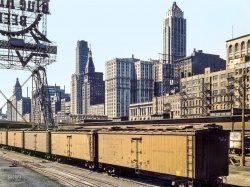
- Frosty Freight: 1942
- ... Looking out toward the icehouse from the freighthouse at a yard of the Chicago and North Western Railroad." Acetate negative by Jack Delano for the Office of War Information. ... Posted by Dave - 03/16/2024 - 8:56pm -
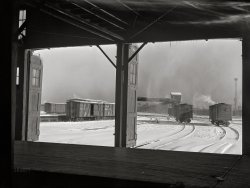
- Proviso Yard, Chicago: 1942
- December 1942. Classification yard at the Chicago & Northwestern Proviso Yard, Chicago. View full size. 4x5 Kodachrome transparency by Jack Delano. ... operate it and did under the watchful eye of various railroad men. If memory is correct there were 9 yards. I did go over the hump ... Posted by Dave - 07/30/2012 - 10:00pm -
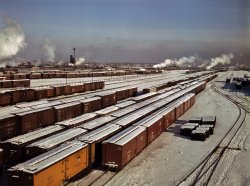
- A's 8, Giants 2: 1913
- ... George Grantham Bain Collection.
Polo Grounds Railroad That should be the Ninth Avenue Elevated line...
... drinking contains several headaches in every bottle.
Railroad in backgound Does anybody know anything about the railroad that can ... Yards The trains seen in this photo are in a layup yard behind left field in the Polo Grounds. These trains were assigned to the ... Posted by Dave - 08/01/2012 - 5:30pm -
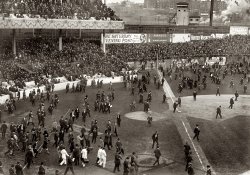
- The Hump Office: 1942
- ... to the hump office at a Chicago & North Western railroad yard, Chicago." 4x5 Kodachrome transparency by Jack Delano for the Office of ... Posted by Dave - 01/16/2014 - 6:12pm -
![The Hump Office: 1942 December 1942. "Switch lists coming in by teletype to the hump office at a Chicago & North Western railroad yard, Chicago." 4x5 Kodachrome transparency by Jack Delano for the Office of War Information. View full size.
The List - Railroad Abbreviations?I can figure out some of the abbreviations in the left column as railroads: SFE = Santa Fe, RDG = Reading, PA = Pennsylvania, NYC = New York Central, RI = Rock Island, MIL = Milwaukee Road. Maybe someone out there can figure out the others: CIM, MP, EJE, COFG, GCX, UTLX, CNW, MDT. I also think the ones in the center column are abbreviations (BELT, PENNA, IHB, IHLOC, CBQ), but of railroads or cities?
20 Years Later...in 1962, a similarly attired C+O clerk, leaning back in a swivel chair, feet up on the console of the Univac 1 at Case Tech, watching the neon lights blink and the metal tapes spin.
C+O's corporate offices were in the Terminal Tower, and a clerk came out to Case every day to run accounting jobs. This was the only use the Univac 1 got at the time, with the Burroughs 220 and the new Univac 1107 taking over student class load.
My phone has more computing power than all of them put together.
Could it be?General MacArthur above the pictured man's head?
[Good catch! Time magazine, December 29, 1941. -tterrace]
The ListClick to enlarge.
Railroad AbbreviationsCIM = Chicago, Illinois, and Midland
MP = Missouri Pacific
EJE = Elgin, Joliet, and Eastern
COFG = Central of Georgia
GCX = General Chemical
UTLX = Union Tank Car Co.
CNW = Chicago & Northwestern
MDT = Merchants Despatch Transportation
Full disclosure: Other than CNW, I had to rely on the magic of the interwebs.
Hump listThe list most likely represents train 284 out of Butler Yard (Milwaukee, Wisconsin) on the Wisconsin Division, with conductor GL Stewart in charge. The 1, 2, 3...designation indicates the first car to go over the hump, the second, etc.
I find in interesting that the official reporting marks of the various railroads are not used. Regarding bigguy1960’s question: CIM represents the Chicago and Illinois Midland railroad. MP represents the Missouri Pacific railroad, often called the Mopac. EJE represents the Elgin Joliet and Eastern railroad, owned by US Steel at the time to handle their product. MDT stood for Merchants Despatch (the “e” is correct) Transportation. CNW was the Chicago and Northwestern railroad, the host railroad for the picture. The X designation in a reporting mark meant the rail equipment was owned by a company other than a railroad. Hence, UTLX refers to the Union Tank Car Company, still with us today.
The “COFG” and “GCX” have me stumped.
The two character designation to the right of the initial/number represents load or empty, and car type. X stands for empty, thus CIM 5449 is an empty “gon,” or gondola. Lines three and four are empty hoppers. Lines 14, 15, 16, 20, 21, 22 and 23 are loads, with a brief description of the lading.
The next block of information indicates which railroad in Chicago the car goes to. The line one through six block will go to the BRC, the Belt Railroad of Chicago. The handwritten twos and sixes are for the pin puller on the hump. He will see a block of six cars and pull the pin “behind six,” instead of scrutinizing each car reporting mark and number.
The two digit number to the right of the off going line represents the cars weight, critically important to the retarder operator. A couple of the cars show “10” tons, and I’m assuming they are wooden sided gons, which would account for their very light relative weight.
Let's dissect a switch listThe very top of the page shows the train's origin and date.
1. The left column is the position number of the car in the train followed by the car initials and number. The double letter indicates car type, i.e.XG, gondola; XM, boxcar, etc.
2. The next column lists the car destination as far as this yard is concerned. Belt would be Belt Railway of Chicago; IHB is Indiana Harbor Belt, with initials after indicating IHB's connecting destination, for instance CBQ is Burlington Route. Most of this train is being delivered to C&NW's connecting railroads in the neighborhood.
3.Third column of typed numbers is the track number the car is headed for. The hand written number shows multiple car cuts. To the right of the track numbers is any special notations or instructions. It looks like "Ride" is the big note, meaning the car should be ridden by a trainman off the hump, to slow the car to prevent damage to lading.
In this time, most humps employed "hump riders", trainmen who controlled speed of cars as they rolled into the tracks by gravity after being uncoupled in motion.
Early in my career, only the yard conductor got a nice printout like this. He would scribble out a simple switchlist for his trainmen that only listed how many cars to which track number. The conductor was the only one who had car numbers to work with; if he missed an extra car, or a car missing, all the work beyond that was wrong and had to be straightened out. (Most guys were careful about that.)
Couple more abbr.BELT = Beltline RR (Chicago local freight)
CBQ = Chicago Burlington & Quincy (Burlington route)
Those Initials and moreCOFG = Central of Georgia (Railroad)
GCX = General Chemical (Company)
WAB - Wabash (Railroad)
The Belt (Railway Company of Chicago) gets all of its empty Railroad owned cars on the same Track 28, but the PENNA (Pennsylvania Railroad) gets its empty PA (Pennsylvania Railroad) cars on Track 10 and an empty RDG (Reading Railroad) car on Track 9.
Thanks, SHORPYAnother learning experience thanks to your superb members.
(The Gallery, Kodachromes, Chicago, Jack Delano, Railroads)](https://www.shorpy.com/files/images/SHORPY_1a34624u.thumbnail.jpg)























